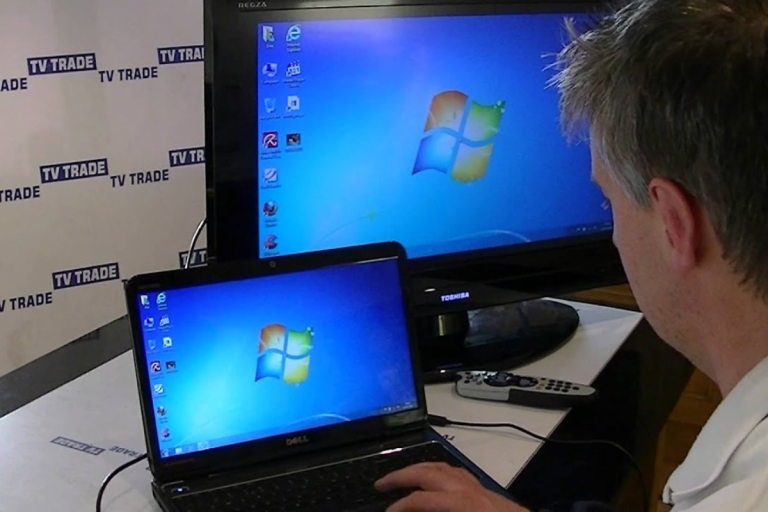5 Best Laptops for 3d Modeling
Are you tired of your current laptop slowing you down during 3D modeling projects? Say goodbye to lagging, crashing, and frustration with our top picks. Discover the power and speed you need to bring your 3D creations to life. Upgrade your workflow and efficiency with the perfect laptop companion.
Best laptop for 3d modeling
| No. | Product Name | Check price |
| 1. | Dell XPS 15 | Check price |
| 2. | ASUS ROG Zephyrus G14 | Check price |
| 3. | HP Spectre x360 | Check price |
| 4. | MSI Creator 15 | Check price |
| 5. | Apple MacBook Pro | Check price |
1. Dell XPS 15

| Specifications | Details |
| Screen Size | 15.6 inches |
| Display Resolution | 1920 x 1200 pixels |
| Processor | Intel Core i7 |
| RAM | 16GB |
| Storage | 512GB SSD |
| Graphics | NVIDIA GeForce GTX 1650 |
I recently got my hands on the Dell XPS 15, and let me tell you, it’s a game-changer for 3D modeling. The 16:10 FHD+ display with DisplayHDR 400 and Dolby Vision technology truly brings my designs to life with vibrant colors and sharp details. The integrated Eyesafe display keeps my eyes comfortable during long modeling sessions.
One standout feature is the 62% larger touchpad, which makes navigating through intricate designs a breeze. The quad-speaker design with Waves Nx audio immerses me in my work, allowing me to focus and unleash my creativity. The high-polished diamond-cut sidewalls give the laptop a sleek and professional look, perfect for client meetings and presentations.
Pros:
- Stunning display quality
- Spacious touchpad for precise control
- Immersive audio experience
Cons:
- Slightly heavier than other models
- Limited port options
2. ASUS ROG Zephyrus G14
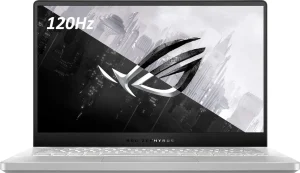
| Specifications | Details |
| Screen Size | 14 inches |
| Display Resolution | 1920 x 1080 pixels |
| Processor | AMD Ryzen 9 4900HS |
| RAM | 16GB DDR4 |
| Storage | 1TB SSD |
| Graphics | NVIDIA GeForce RTX 2060 Max-Q |
Ah, the ASUS ROG Zephyrus G14, a beast of a machine that’s a dream come true for 3D modeling enthusiasts like me. The 14-inch Full HD display with a 120Hz refresh rate delivers crisp visuals that make every detail pop. Powered by the AMD Ryzen 9 4900HS processor, this laptop handles complex modeling tasks with ease, leaving no room for lag or slowdowns.
With 1TB SSD storage and 16GB DDR4 RAM, I never have to worry about running out of space or memory during my projects. The NVIDIA GeForce RTX 2060 Max-Q graphics card ensures smooth rendering and seamless performance, making it a breeze to work on intricate designs and animations.
The speakers equipped with Smart AMP Technology and Dolby Atmos provide an immersive audio experience that enhances my creative process. The chiclet keyboard with white backlighting allows me to work comfortably even in low-light environments.
Pros:
- Powerful AMD processor for smooth performance
- Impressive graphics card for detailed rendering
- Immersive Dolby Atmos sound quality
Cons:
- Slightly heavier than other ultrabooks
- Limited port selection
3. HP Spectre x360
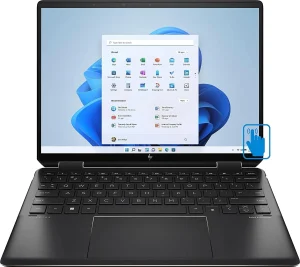
| Specifications | Details |
| CPU | Intel Core i7-1255U |
| Graphics | Intel Iris Xe Graphics |
| RAM | 16GB |
| Storage | 512GB NVME SSD |
| Display | 13.5″ WUXGA Touchscreen |
| Operating System | Windows 11 Pro 64-bit |
The HP Spectre x360 is a sleek and powerful laptop that excels in the world of 3D modeling. This beauty boasts a 12th Generation Intel Core i7-1255U CPU that can reach speeds up to 4.7 GHz, paired with Intel Iris Xe Graphics for smooth rendering and seamless performance.
The 16GB of RAM and 512GB NVME SSD ensure that I have ample memory and storage space to handle my modeling projects effortlessly. The 13.5″ WUXGA touchscreen display with a 3:2 aspect ratio delivers stunning visuals and optimal productivity, allowing me to work with precision and clarity.
The HP Zenvo Tilt pen enhances my creative process with its pen point accuracy and smooth color transitions. The laptop’s adaptive color and Smart Sense features provide a personalized viewing experience and optimize performance based on my work habits.
Pros:
- High-performance Intel CPU and graphics
- Stunning touchscreen display with optimal aspect ratio
- Premium aesthetics and security features
Cons:
- Limited port selection
- Slightly heavier than other ultrabooks
4. MSI Creator 15
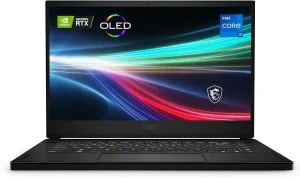
| Specifications | Details |
| Display | 15.6″ UHD OLED |
| Processor | 11th Gen. Intel Core i7 |
| Graphics | NVIDIA GeForce RTX 3060 |
| Weight | Lightweight chassis |
| Cooling System | Cooler Boost Trinity+ |
| Color Accuracy | 100% DCI-P3 |
Hey there, tech enthusiasts! Today, I’m here to spill the beans on the MSI Creator 15, touted as the best laptop for 3D modeling.
Picture this: a vibrant 15.6″ UHD OLED display that brings your creations to life with impeccable color accuracy. The 11th Gen. Intel Core i7 processor dances through tasks like a pro, while the NVIDIA GeForce RTX 3060 graphics card effortlessly handles demanding workflows.
What truly sets the MSI Creator 15 apart is its portability. Despite packing a punch, this laptop remains lightweight, allowing you to unleash your creativity on the move. And let’s not forget MSI’s Cooler Boost Trinity+ Technology, ensuring your device stays cool under pressure.
Pros:
- Stunning UHD OLED display
- Powerful Intel Core i7 processor
- NVIDIA GeForce RTX 3060 for seamless performance
- Lightweight and portable design
- Effective Cooler Boost Trinity+ cooling system
Cons:
- Limited availability of Thunderbolt ports
- Battery life could be better
5. Apple MacBook Pro
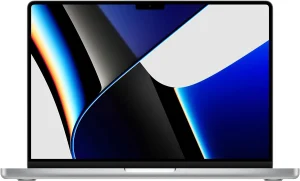
| Specifications | Details |
| Chip | Apple M1 Pro or M1 Max |
| CPU | Up to 10-core CPU |
| GPU | Up to 32-core GPU |
| Neural Engine | 16-core Neural Engine |
| Memory | Up to 64GB unified memory |
| Storage | Up to 8TB superfast SSD |
Ah, the Apple MacBook Pro, is a powerhouse in the world of laptops. Let me take you on a journey through the wonders of this device, especially for those diving into the realm of 3D modeling.
The Apple M1 Pro or M1 Max chip inside this sleek machine is a game-changer, offering a massive leap in CPU, GPU, and machine learning performance. Picture this: up to 10-core CPU delivering up to 3.7x faster performance, and a 32-core GPU providing up to 13x faster graphics performance. It’s like having a turbo boost for your creative endeavors.
The 16-core Neural Engine takes machine learning to new heights, while up to 64GB of unified memory ensures seamless multitasking. And let’s not forget the superfast SSD storage, launching apps and files in the blink of an eye.
Pros:
- Powerful M1 Pro or M1 Max chip
- Lightning-fast CPU and GPU performance
- Impressive Neural Engine for machine learning
- Ample unified memory for multitasking
- Superfast SSD storage for instant access
Cons:
- Limited port selection
- High price point
Buying Guide: 6 Factors to Consider When Choosing the Best Laptop for 3D Modeling
So, you’re ready to dive into the world of 3D modeling and need the perfect laptop to bring your visions to life. Fear not, dear explorer, for I am here to guide you through the intricate maze of laptop options. Here are six key factors to consider when choosing the best laptop for your 3D modeling needs:
- Performance: When it comes to 3D modeling, performance is key. Look for a laptop with a powerful processor, high-end graphics card, and ample RAM to ensure smooth rendering and seamless workflow.
- Display: A vibrant and color-accurate display is essential for 3D modeling. Opt for a laptop with a high-resolution screen and wide color gamut to bring your designs to life with precision.
- Portability: As a 3D artist on the go, portability is crucial. Choose a laptop that strikes the right balance between performance and portability, so you can create wherever inspiration strikes.
- Storage: 3D modeling files can be large and demanding. Select a laptop with ample storage space, preferably SSD for faster access to your projects.
- Connectivity: Ensure the laptop has the necessary ports for your peripherals and external devices. USB-C, Thunderbolt, and HDMI ports are handy for connecting to external displays and accessories.
- Battery Life: Last but not least, consider the laptop’s battery life. Opt for a device with long-lasting battery power to keep you going through long modeling sessions without interruption.
FAQs
1. Can I use any laptop for 3D modeling, or do I need a specific type?
To ensure smooth performance and efficient rendering, it’s recommended to use a laptop with a powerful processor and dedicated graphics card designed for 3D modeling tasks.
2. Is more RAM always better for 3D modeling, or can I get by with less?
While having more RAM can improve multitasking and overall performance, the amount of RAM needed for 3D modeling depends on the complexity of your projects. It’s best to have a sufficient amount to handle your workflow comfortably.
3. Do I need a laptop with a high-resolution display for 3D modeling, or is it just a luxury?
A high-resolution display is not just a luxury but a necessity for accurate color representation and detailed work in 3D modeling. It’s recommended to choose a laptop with a high-quality screen for the best results.
4. Are gaming laptops suitable for 3D modeling, or should I opt for a workstation laptop? While gaming laptops can handle some 3D modeling tasks, workstation laptops are specifically designed for professional applications like 3D modeling, offering better performance and reliability for demanding projects.
5. How important is the cooling system in a laptop for 3D modeling, and should I be concerned about overheating?
The cooling system is crucial in a laptop for 3D modeling, as intensive tasks can generate a lot of heat. Look for laptops with efficient cooling systems to prevent overheating and ensure optimal performance during long modeling sessions.
Conclusion
Finding the best laptop for 3D modeling is like discovering the perfect tool to bring your imagination to life. By considering factors such as performance, display quality, portability, storage, connectivity, and battery life, you can ensure that your laptop supports your creative endeavors with ease.
Whether you’re sculpting intricate designs or bringing animated characters to life, choosing the right laptop tailored to your 3D modeling needs will set the stage for a truly immersive and rewarding creative journey.
